Black birds are intriguing birds, whether you find them loud pests or cunning and brilliant acrobats. Despite being called “black birds,” they are sometimes brightly colored and belong to the Icteridae family of songbirds.
They are known as New World Blackbirds across North America to distinguish them from European Blackbirds, which seem to be representatives of the Thrush family.
There are 25 species of New World Blackbirds found throughout North America, notably Meadowlarks, Blackbirds, Cowbirds, Bobolinks, Orioles, and Grackles.
Of the 25 blackbird species throughout North America, 24 are recognized on state checklists as routinely occurring, one can be considered uncommon or unexpected, and four are on the red list of endangered birds in some form.
Male and female blackbirds might vary dramatically in size and color, typically males being around 60% bulkier than females and several displaying much brighter colors.
Blackbirds can push their bills wide in order to prize wide gaps to reach concealed food, but other birds cannot.
Blackbirds are regarded as an agricultural nuisance because of their ability to eat large amounts of grains and seeds.
In fact, Bobolink populations have declined by up to 60% over the last 50 years, owing to repression and deteriorating habitat.
Several blackbirds migrate, particularly from northern places. You can see how prevalent each blackbird is in winter and summer at the conclusion of the article to assist you in determining when to search for them.
Here are the 12 types of black birds in North America.
| Image | Name |
|---|---|
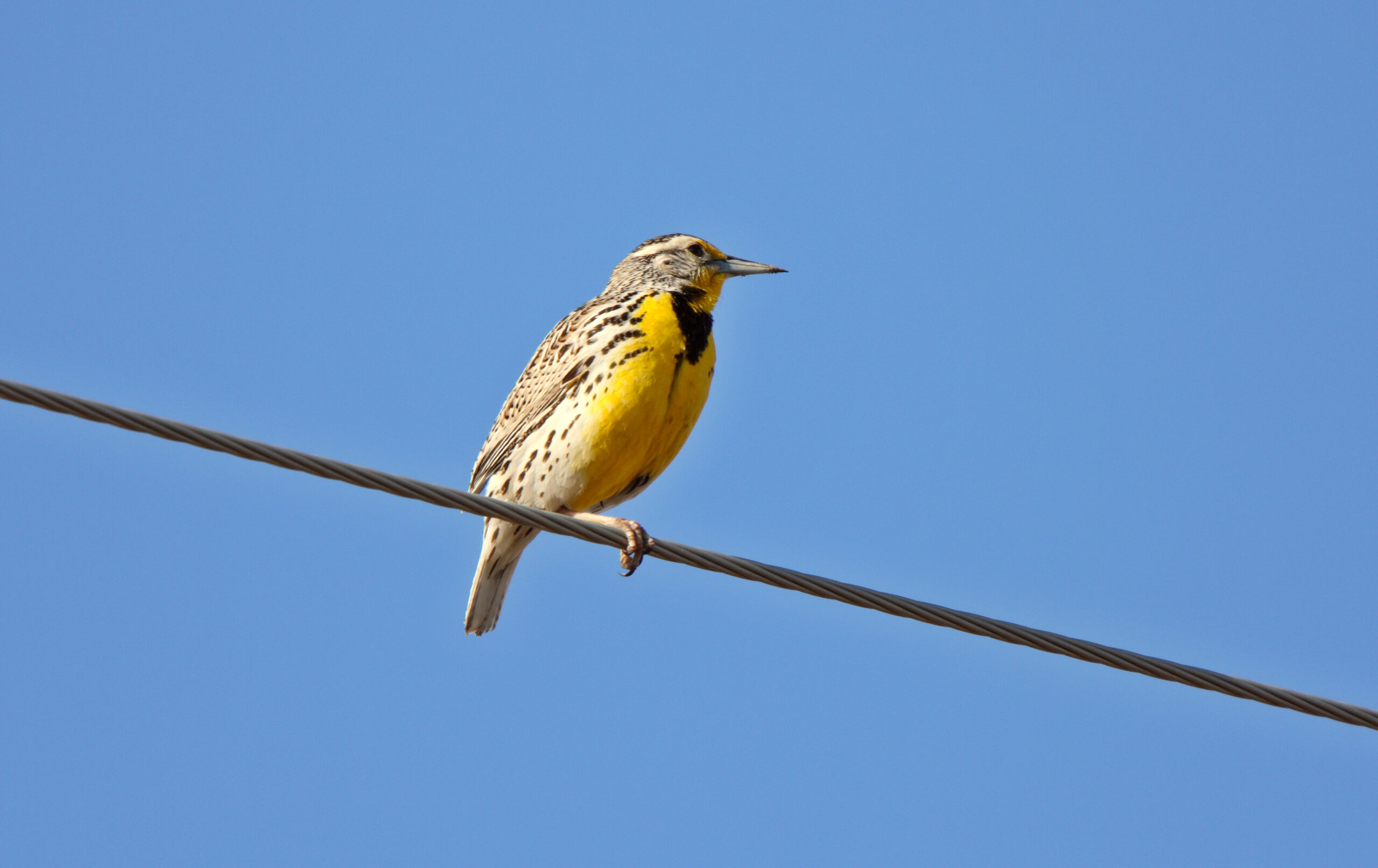 | Western Meadowlark |
 | Red-winged Blackbird |
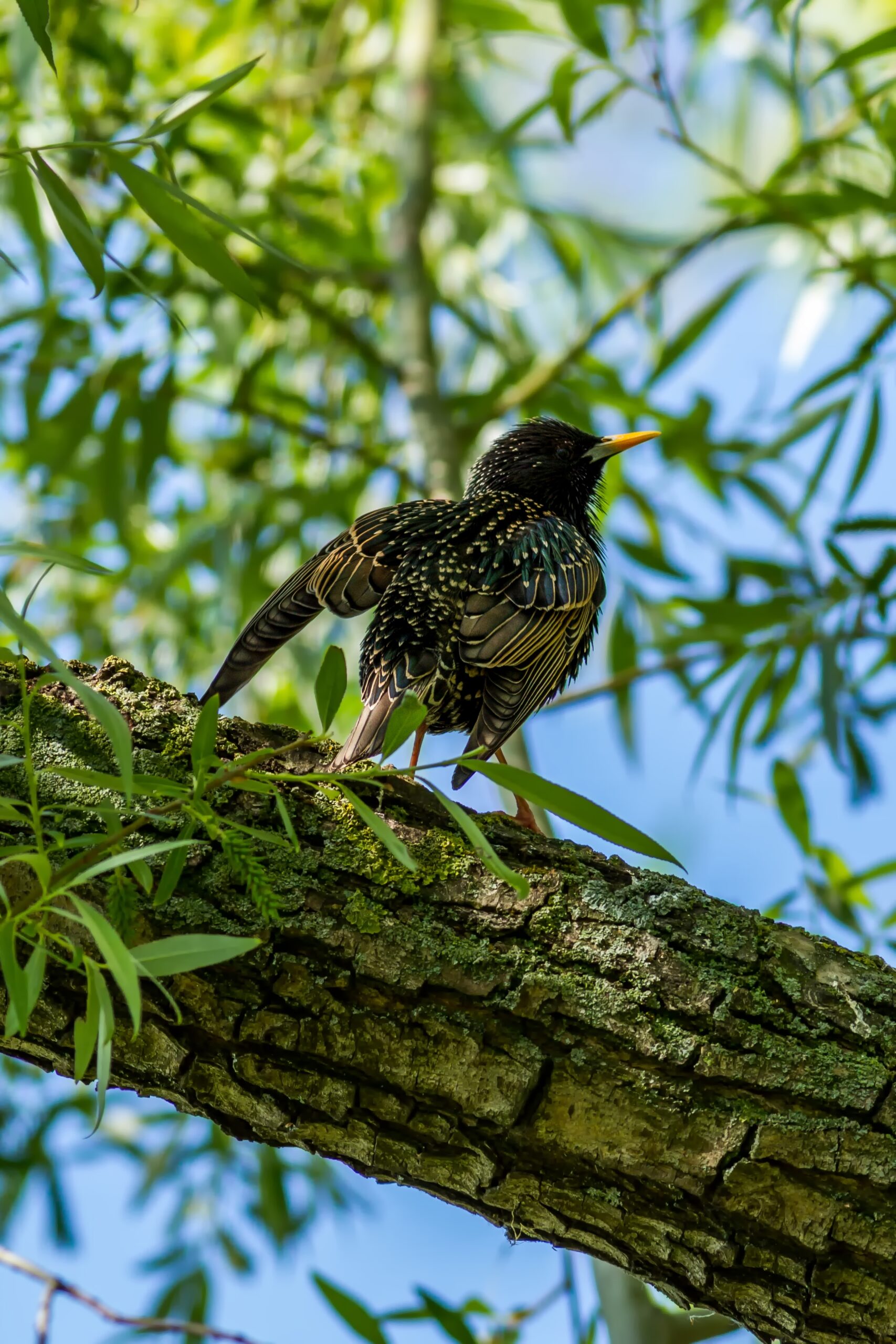 | European Starling |
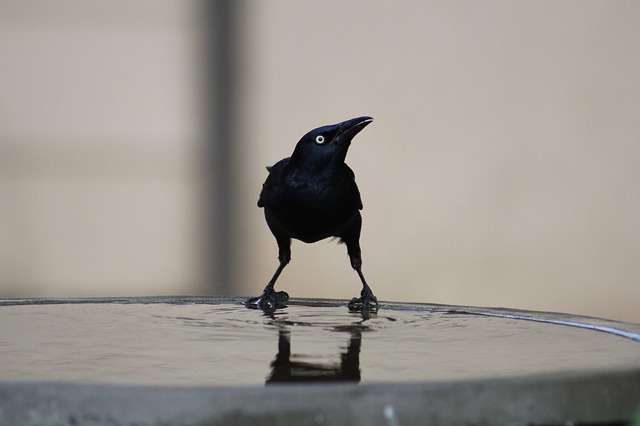 | Common Grackle |
 | Brown-headed Cowbird |
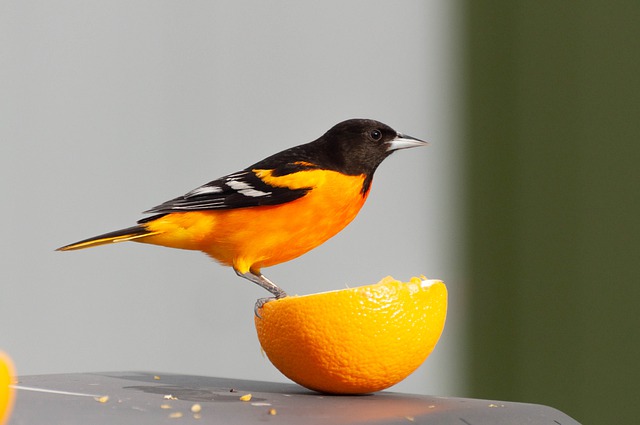 | Baltimore Oriole |
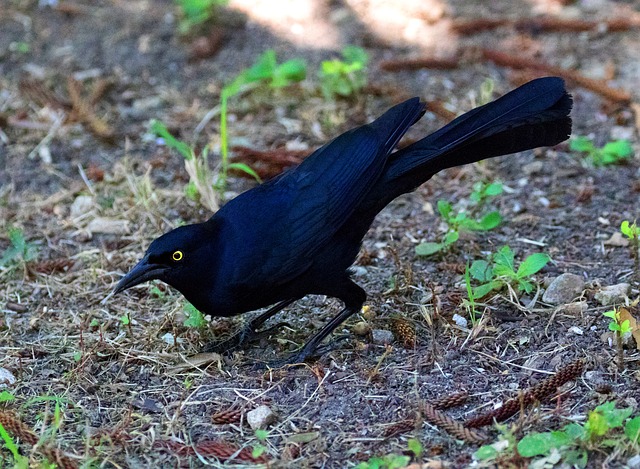 | Great-tailed Grackle |
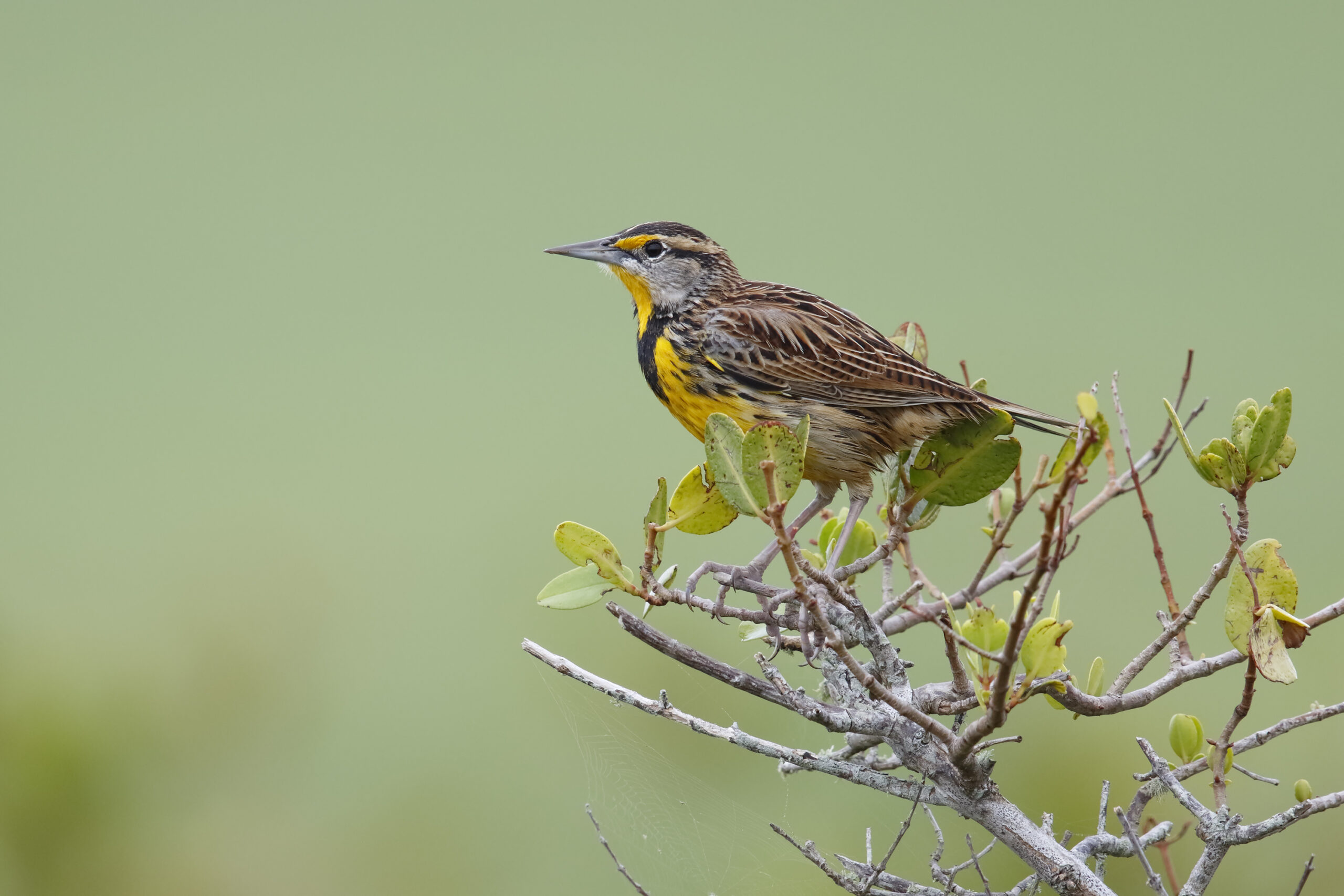 | Eastern Meadowlark |
 | Brewer's Blackbird |
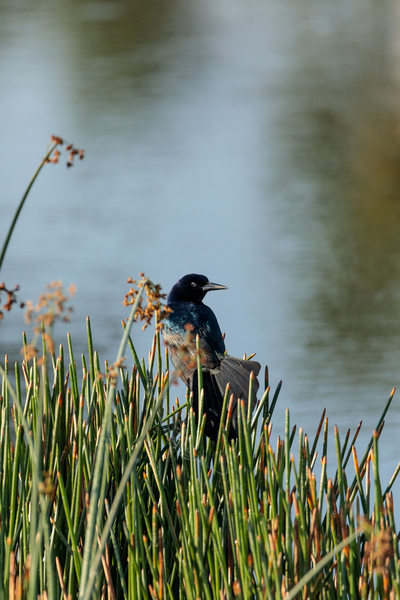 | Boat-tailed Grackle |
 | Orchard Oriole |
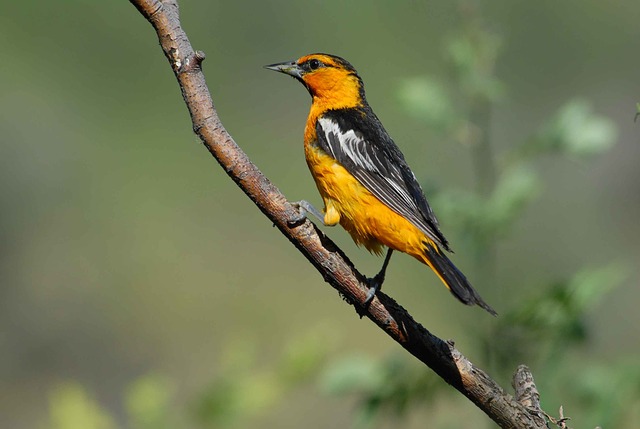 | Bullock's Orioles |
Types of Black Birds in North America
1. Western Meadowlark

With their stunning yellow belly and charming sound, Western Meadowlarks can cheer the evening.
Western Meadowlarks resemble blackbirds featuring brown and white top parts and a black V-shaped band across the vivid yellow chest, which becomes grey mostly in winter.
They’re around the shape of a Robin.
Western Meadowlarks that nest throughout northern Canada and the United States move south during the winter, while those in the midwest stay all year.
Western Meadowlarks are mainly found on the ground among grasslands, meadows, and fields. They hunt for food alone or in small groups and are seldom seen in woodlands or thick shrubby vegetation.
Western Meadowlarks feed on insects and seeds. They also consume many insects, while in the winter season, they prefer to eat seeds and grain. They produce a wonderful cacophony of tweets, warbles, and whistles.
Western Meadowlarks build their nests in grassy depressions. This is packed with soft fabric like grass and could have a roof composed of grass and plant stems on top.
Sunflower seeds and broken corn can entice Western Meadowlarks into your backyard.
| Scientific Name | Sturnella neglecta |
| Weight | 3.2 to 4.2 ounces (88 to 116 grams) |
| Length | 6.2 to 10.4 inches (15 to 28 centimeters) |
| Wingspan | 16.1 to 16.3 inches (41 to 49 centimeters) |
2. Red-winged Blackbird
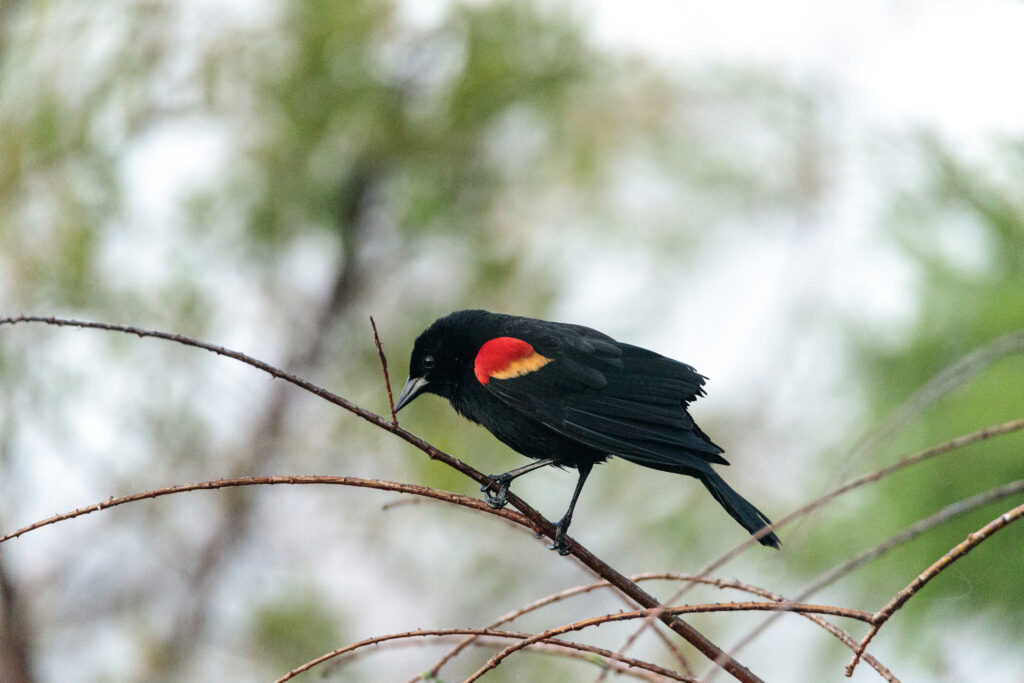
Red-winged blackbirds are quite numerous and simple to distinguish since they are entirely black apart from the reddish-orange wing bands. Females are drab in comparison to their streaky brown coloration.
Red-winged Blackbirds may be seen throughout the entire lower 48 and on British Columbia’s Pacific Coast. Those that nest across Canada and parts of the upper 48 move south for the winter.
Red-winged Blackbirds are often seen perched on telephone lines. They prefer moist environments like marshes, although they may nest in fields and meadows as well.
During the mating season, males will actively safeguard their territory, even attacking those who come too near to their nests. During the winter, they roost by the millions.
Red-winged blackbirds mostly consume insects in the summer and seeds in the winter. They write a brief tune that sounds similar to ‘Okelee’ and is dragged out in conclusion.
Red-winged Blackbirds build their nests in thick plants near the ground. The nest will be constructed by constructing a platform made of surrounding plant stems and stalks. Mud and wet leaves will be used to construct a cup, and soft dry grass will be used as the liner.
They lay two to four eggs and approximately take thirteen days for hatching and another two weeks for the young to fledge.
Bring Red-winged Blackbirds to your backyard by spreading mixed grain and seeds on the floor. They will eat from platform feeders or large tube feeders as well.
| Scientific Name | Agelaius phoeniceus |
| Weight | 1.2 to 2.6 ounces (31 to 78 grams) |
| Length | 6.6 to 9.2 inches (17-23 centimeters) |
| Wingspan | 12.3 to 15.9 inches (30 to 41 centimeters) |
3. European Starling
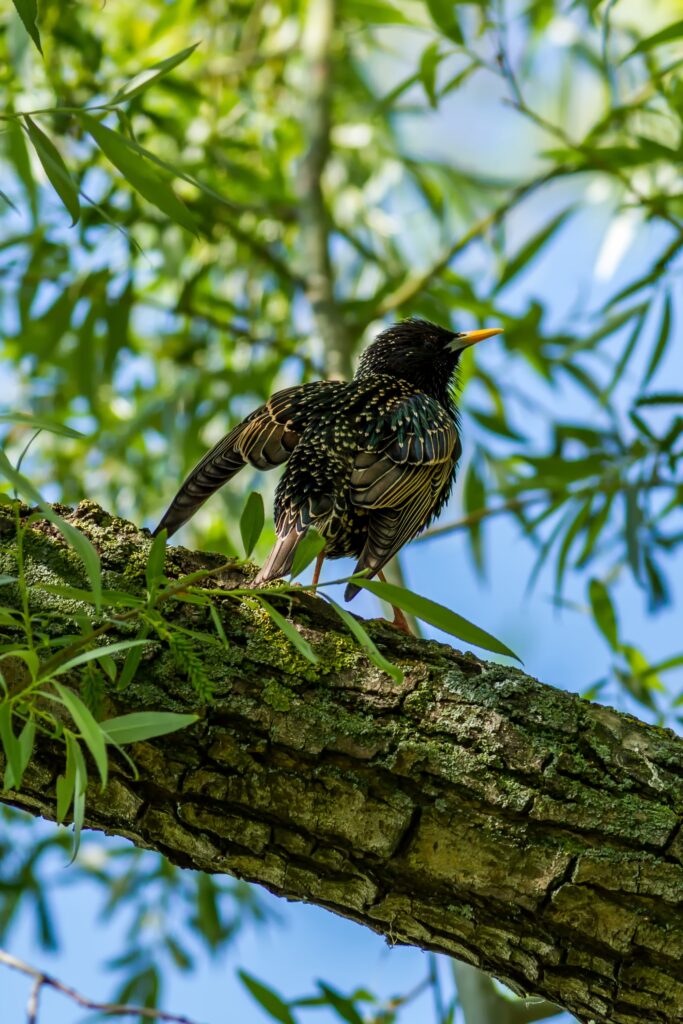
European starlings are still not native to Europe, yet they have emerged as one of the most abundant songbirds. They are stocky blackbirds having green, purple, and blue iridescent tones.
European Starlings may be found across North America, with the exception of northern Alaska and Canada.
They are considered a nuisance because of their huge, loud flocks and aggressive temperament. They are frequently seen sitting in flocks on the tops of trees or soaring over fields.
Starlings feed on insects such as earthworms, flies, caterpillars, beetles, and spiders. Fruit such as holly berries, Virginia Creeper, mulberries, sumac, cherries, and blackberries, as well as seeds and grains, will be consumed.
The starling’s sounds and songs include whistles, warbles, and chatter, and they may even imitate the calls of many other birds. They frequently congregate in loud groups.
Habitat & Food
Starling nests are frequently found in structures or nest boxes and are built of pine needles, grass, and other soft material. They lay 3 to 6 eggs and hatch in 12 days. Fledging takes about three weeks.
Black oil sunflower seeds, peanuts, suet, and cracked corn can entice more European Starlings toward your garden feeders.
| Scientific Name | Sturnus vulgaris |
| Weight | 2.2 to 3.5 ounces (61 to 95 grams) |
| Length | 7.8 to 9.2 inches (20 to 24 centimeters) |
| Wingspan | 12.1 to 15.7 inches (30 to 41 centimeters) |
4. Common Grackle

Common Grackles are blackbirds having shiny iridescent bodies that are taller and have longer tails than other blackbirds. Females have a little less shiny appearance than males.
Common Grackles live in the southern states year-round, although those that breed across Canada and the Midwest travel south.
Habitat
Their habitat consists of open forests, parks, marshes, and fields. They consume a variety of crops, mostly maize, and congregate in large flocks high in the trees. They will also devour rubbish, making them a nuisance.
Despite gathering in the millions, they are classified as near endangered by the IUCN owing to a 50% fall in population since the 1970s.
Typical Grackle noises include squeaks, croaks, and whistles.
Common Grackle nests are comprised of leaves, twigs, and grasses and are built high up among conifer trees close to water. They lay one to seven eggs, which hatch in approximately two weeks and fledge in about another two weeks.
Entice Common Grackles towards your backyard by scattering mixed seed and grain on the floor or even in platform feeders.
| Scientific Name | Quiscalus quiscula |
| Weight | 2.5 to 5.0 ounces (73 to 143 grams) |
| Length | 11.1 to 13.5 inches (27 to 35 centimeters) |
| Wingspan | 14.1 to 18.2 inches (35 to 47 centimeters) |
5. Brown-headed Cowbird

Brown-headed man Cowbirds have brown heads, short tails, and black bodies. Females have been gray-brown all over and have faint streaking.
Brown-headed Cowbirds live throughout the year in the south, east, and on the Pacific coast, while those that nest around the west, north, and Canada move south for the winter.
Habitat
Brown-headed Cowbirds are found in meadows and pastures but not in forested regions. They graze on the ground, particularly near grazing animals, hoping that they would kick up some food for them.
Food
The majority of their food consists of grasses and weed seeds, although they also consume insects. Female cowbirds consume eggs and shells for calcium, and they’ll also go to garden feeders.
Their song does have a watery aspect to it, consisting of a sequence of fast, high-pitched whistles and gurgling sounds that last just a few seconds. They also make brief telephone conversations.
Brown-headed Cowbirds don’t really lay eggs. They are frequently regarded as a nuisance because they damage the eggs of tinier songbirds in order to lay their own eggs in the nest and let the bird care for their chicks.
If they take their egg, they might torment the host or damage the nest.
| Scientific Name | Molothrus ater |
| Weight | 1.4 to 1.9 ounces (42 to 50 grams) |
| Length | 76.4 to 8.8 inches (19 to 23 centimeters) |
| Wingspan | 14.2 inches (36 centimeters) |
6. Baltimore Orioles

Baltimore Orioles are a brightly colored symbol of spring across North America’s east. Adult males are vivid orange and black in color, with white wing bands on their black wings.
Females have yellowish undersides and heads, grayish-brown wings, and brownish-yellow upper backs. They are blackbirds that are approximately the size of a Robin but even more slender.
Baltimore Orioles breed mostly in the central and eastern United States, as well as the central-southern Canadian regions and near the United States’ southern border.
The Baltimore Orioles then spend the winter visiting Central America, Florida, and the Caribbean, departing as early as July.
Habitat & Food
Baltimore Orioles forage for bugs and fruit across riverbanks, open woods, and forest margins, and they frequently visit parkland and backyards.
Insects like crickets, beetles, grasshoppers, and also snails, and spiders comprise their diet. They also assist in consuming pest species and a broad variety of foods, and they may harm crops, including oranges, cherries, mulberries, bananas, and raspberries.
Among the pleasures of spring is the flute-like melody of the Baltimore Orioles. They also emit chattering and piercing warning sounds.
Using oranges sliced in half on a station feeder or dangling them from branches, you may entice Baltimore Orioles to the backyard.
Try oriole feeders using sugar water as well. Planting fruiting and nectar plants like raspberries, crab apples, and trumpet vines will also assist in attracting them.
| Scientific Name | Icterus galbula |
| Weight | 1.2 to 1.4 ounces (30 to 40 grams) |
| Length | 6.6 to 7.6 inches (16 to 19 centimeters) |
| Wingspan | 9.2 to 11.8 inches (22 to 30 centimeters) |
7. Great-tailed Grackle

Male Great-tailed Grackles have long tapered tails and are long and slender blackbirds. Males have iridescent black skin and bright yellow eyes.
Females are equally long-legged and thin, but their backs are dark brown, and their undersides are paler brown, with a little more slender tails.
Great-tailed Grackles may be spotted in the Midwest and West across urban and agricultural regions where people reside.
Food
Grains, fruit, and seeds are stapled foods for Great-tailed Grackles, as are insects and other creatures, including worms, slugs, spiders, beetles, snails, and bees.
They can often consume small animals and lizards, in addition to eggs and hatchlings. They have an incredible variety of shrieks, whistles, and rattles.
Great-tailed Grackle nests are often high up in trees and comprised of weeds, twigs, and grass. The nest is first lined with mud, then with soft grass.
Great-tailed Grackles can often be seen parading over your yard, drawn by seeds dropped from feeders above. On platform feeders or huge hopper feeders, they will also consume cracked maize, millet, and black oil sunflower seeds.
| Scientific Name | Quiscalus mexicanus |
| Weight | 3.6 to 6.7 ounces (104 to 190 grams) |
| Length | 15.1 to 18.2 inches (38 – 46 centimeters) |
| Wingspan | 18.8 to 22.8 inches (48 – 58 centimeters) |
8. Eastern Meadowlark
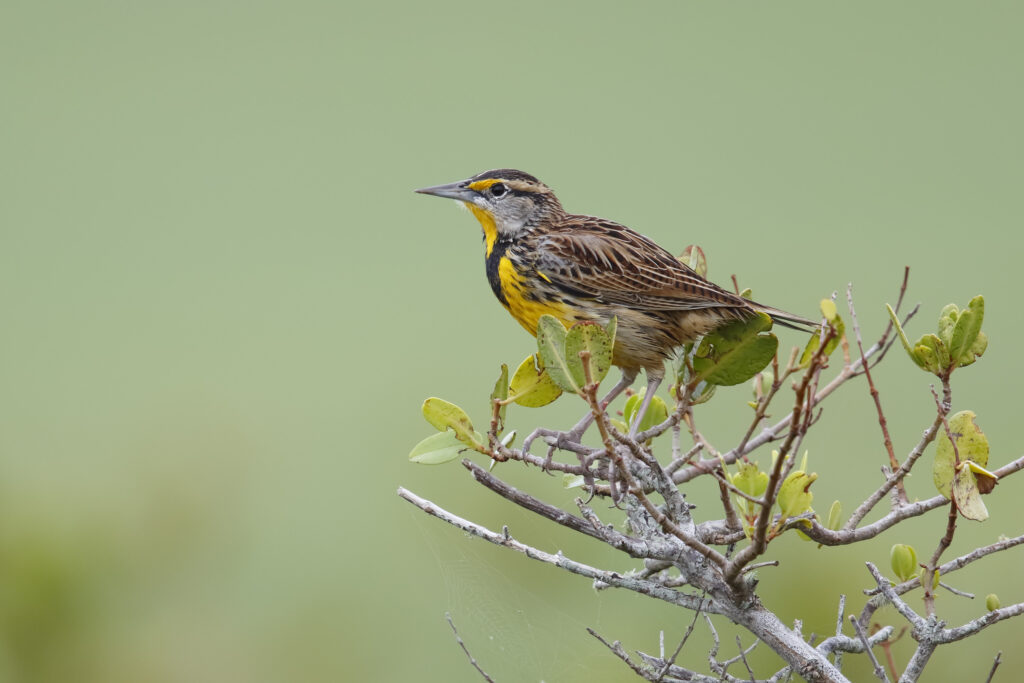
Eastern Meadowlarks seem to be medium-sized songbirds having brilliant yellow underwings and light brown backs with black markings. They are distinguished by a black stripe across the breast.
Eastern Meadowlarks may be seen all year in the eastern United States, but they’ll also nest across the Northeast and Canada until moving south.
Spring has entered the East once the Eastern Meadowlark begins to sing and put on a show, but they’ve been classified as near-threatened.
Food
They feed on insects and may be observed on the ground in meadows and grasslands. During the winter, they congregate in great numbers in fields in search of seeds.
They produce clear and musical flute-like whistles.
Eastern Meadowlark nests are also on the land and may be very remarkable, with tunnels and ceilings constructed of braided grasses.
| Scientific Name | Sturnella magna |
| Weight | 3.1 to 5.3 ounces (91 to 150 grams) |
| Length | 7.6 to 10.2 inches (19 to 25 centimeters) |
| Wingspan | 13.7 to 15.8 inches (35 to 40 centimeters) |
9. Brewer’s Blackbird

Brewer’s Blackbirds are generally medium-sized blackbirds having glossy black feathers and purple coloration on the head and a greenish iridescent shade of blue on the body in the males. Females are uniformly brown.
Brewer’s Blackbirds may be distributed across the United States and southern Canada, with the exception of the Northeast, and others in the west don’t really migrate.
Those in central and northern states and territories, on the other hand, move south to Mexico And the United States for the winter. They may be observed in the eastern states after migration.
Habitat & Food
Brewer’s blackbirds may be found in a range of habitats, including marshes, meadows, grasslands, beaches, and forests, as well as fields, parkland, and gardens. They mostly consume grains, seeds, insects, and anything else they may get.
Brewer’s blackbirds have very short and harsh songs, as well as ‘chuk’ cries.
Brewer’s Blackbird nests are built of tangled twigs and grass inside shrubs or trees. The nest should be first coated with mud to keep it all together, and afterward, the cup should be covered with soft dry grass.
Ground feeders filled with cracked maize, millet, and hulled sunflower seeds will entice Brewer’s blackbirds.
| Scientific Name | Euphagus cyanocephalus |
| Length | 7.98 to 9.8 inches (21 to 25 centimeters) |
| Weight | 1.9 to 3.1 ounces (50 – 86 grams) |
| Wingspan | 14.6 inches (37 centimeters) |
10. Boat-tailed Grackle

Males of the Boat-tailed Grackle are big glossy black songbirds with long sharp bills, long legs, and a long tail. Females are approximately half the size of males, with dark brown backs and paler brown underneath.
Boat-tailed Grackles can be found all across Florida near saltwater, including the Gulf Coast. They may be seen searching for abandoned food around marsh borders, beaches, parks, and in cities.
Food
They eat whatever they can get their hands on, from seeds and crustaceans to food trash.
Boat-tailed eagle nests Grackles nest in tall grasses near marshes, making a cup out of woven stems and grass and filling it with wet mud and leaves.
The soft grass and pine twigs are put in. One to five eggs hatch, and the hatching and fledging processes typically take around two weeks.
Platform feeders containing sunflower seeds, millet, or maize can bring more Boat-tailed Grackles toward the yard.
Boat-tailed Grackles create female harems, and only the highest-ranking male may mate. They can create large flocks, like one found in a Texas parking lot.
Their song consists of a sequence of jeep-jeep-jeep noises, which frequently conclude with a higher pitch squeak. As a warning, they shriek and click.
| Scientific Name | Quiscalus major |
| Weight | 3.4 to 8.5 ounces (91 to 239 grams) |
| Length | 10.21 to 14.5 inches (26 to 37 centimeters) |
| Wingspan | 15.4 to 19.7 inches (38 to 50 centimeters) |
11. Orchard Oriole

Females of the Orchard Oriole appear greenish to yellow overall, whiter underneath and deeper on the back, having darker wings and white wing bars.
Males have considerably distinct coloration than females. They possess reddish undersides and blackheads, and upper backs.
Orchard Orioles breed mostly in the eastern portion of the United States throughout the summer before traveling south to Mexico and Central America.
Habitat & Food
Orchard Orioles like open woods, although they may also be seen near river sides, farms, backyards, and open shrubland. They make pouch-like nests that dangle from the trees.
Their food consists mostly of insects like beetles, ants, spiders, caterpillars, and grasshoppers. They will also sip floral nectar and consume food, including chokeberries and mulberries.
They blow a garbled succession of whistles for three to four seconds.
Orchard Oriole nests are cups constructed of long grasses dangling from tiny tree branches. They deposit 4 to 6 eggs, which lay eggs in around two weeks.
Hummingbird feeders or platform feeders filled with sliced oranges or mangoes can bring Orchard Orioles to your yard. Plant native berry plants as well, such as chokeberries or mulberries.
| Scientific Name | Icterus spurius |
| Weight | 0.61 to 1.05 ounces (16.3 to 28.4 grams) |
| Length | 5.8 to 7.2 inches (15 to 18 centimeters) |
| Wingspan | 9.7 inches (27 centimeters) |
12. Bullock’s Orioles

Male Bullock’s Orioles are brilliant orange having black and white wing patterns and a black crown.
Females and juveniles have grey backs and yellow tails, breasts, and heads.
Bullock’s Orioles spend their winter near Mexico and breed mostly in the western portion of the United States.
Bullock’s Orioles may be seen searching for fruit, nectar, and insects in parks and open forests.
They create a succession of short-lived cheeps and whistles.
Sugar water, fruit, and jelly will attract Bullock’s Orioles to the garden.
Their gourd-shaped nests are constructed from grass, hair, and wool and may take a maximum of fifteen days to create.
| Scientific Name | Icterus bullockii |
| Weight | 1.1 to 1.6 ounces (28 to 43 grams) |
| Length | 6.6 to 7.6 inches (17 – 19 centimeters) |
| Wingspan | 12.3 inches (31 centimeters) |
Check out this article on the Types of Black Birds in California.
Conclusion
A vast range of Black bird species may be found in North America. Even though the Blackbirds family of birds has certain characteristics, each species could be quite distinct!
They exist in a range of sizes, from little to enormous. After going through this article, you will be able to identify or recognize any Blackbirds around your home.
FAQ
What do you call all blackbirds?
Although there are numerous other types of blackbirds, we may focus on the most common types: the Common Grackle, American Crow, European Starling, Common Raven, and Brown-headed Cowbird.
Where can you find common blackbirds?
Breeding grounds for common blackbirds include Europe, North Africa, India, and southern China. Populations from the east and north travel towards Egypt and the southeast and west of Asia during the winter.
Common blackbirds might well be resident, somewhat migratory, or entirely migratory based on their latitude.
Last Updated on March 22, 2023 by Lily Aldrin
